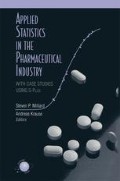Abstract
The number of subjects is an important design parameter in clinical trials. The key information when planning the sample size is the postulated effect and its variation. The effect size may come from prior trials, from literature review, or quite often from the best guess by the investigator.
Access this chapter
Tax calculation will be finalised at checkout
Purchases are for personal use only
Preview
Unable to display preview. Download preview PDF.
References
Berger, J. (1985). Statistical decision theory and Bayesian analysis. 2nd ed. Springer-Verlag, New York.
Bernardo, J. and Smith, A. (1994). Bayesian Theory. Wiley, New York.
Bernardo, J., Berger, J. Dawid, A., and Smith, A., eds. (1992). Bayesian Statistics 4. Oxford University Press.
Casella, G., and George, E. (1992). Explaining the gibbs sampler. The American Statistician 46, 167–174.
Chib, S., and Greenberg, E. (1995). Understanding the metropolis-hastings algorithm. The American Statistician 49 (4), 327–35.
Cowles, M., and Carlin, B. (1996). Markov chain monte carlo convergence diagnostics: A comparative review. Journal of the American Statistical Association 91 (434), 883–904.
Dempster, A., Laird, N., and Rubin, D. (1977). Maximum likelihood from incomplete data via the em algorithm (with discussion). Journal of the Royal Statistical Society, Series A 132, 234–244.
Diebolt, J., and Robert, C. (1994). Estimation of finite mixture distributions through bayesian sampling. Journal of the Royal Statistical Society, Series B 56, 363–375.
Draper, D. (1998). Bayesian hierarchical modeling. Manuscript preprint, 2nd version, available from: http://www.bath.ac.ukrmasdd/ home.html.
Escobar, M., and West, M. (1995). Bayesian density estimation and inference using mixtures. Journal of the American Statistical Association 90 (2), 577–588.
Gelfand, A., and Smith, A. (1990). Sampling—based approaches to calculating marginal densities. Journal of the American Statistical Association 85, 398–409.
Gelman, A., and Rubin, D. (1992a). Inference from iterative simulation using multiple sequences (with discussion). Statistical Sciences 7 (4), 457–511.
Gelman, A., and Rubin, D. (1992b). A Single Series From the Gibbs Sampler Provides a False Sense of Security. In: Bernardo et.al. (1992).
Gelman, A., Carlin, J., Stern, H., and Rubin, D. (1995). Bayesian Data Analysis. Chapman and Hall, London.
Geman, S., and Geman, D. (1984). Stochastic relaxation, gibbs distributions and the bayesian restoration of images. IEEE Transactions on Pattern Analysis and Machine Intelligence 6, 721–741.
Geyer, C. (1992). Practical markov chain monte carlo. Statistical Sciences 7 (4), 473–483.
Gilks, W., and Wild, P. (1992). Adaptive rejection sampling for gibbs sampling. Journal of the Royal Statistical Society, Series C 41, 337–348.
Gilks, W., Richardson, S., and Spiegelhalter, D., eds. (1996). Markov Chain Monte Carlo in practice. Chapman and Hall, London.
Gould, A., and Shih, W. (1992). Sample size re-estimation without un-blinding for normally distributed outcomes with unknown variance. Communications in Statisctics 21 (10), 2833–2853.
Krause, A. (1994). Computerintensive statistische Methoden- Gibbs Sampling in Regressionsmodellen. Fischer, Stuttgart.
Learner, E. (1978). Specification Searches. Wiley, New York.
Meng, X., and Rubin, D. (1993). Maximum likelihood estimation via the ecm algorithm: A general framework. Biometrika 80 (2), 267–78.
Peace, E., ed. (1992). Biopharmaceutical Sequential Statistical Applications. Marcel Dekker, New York.
Raftery, A., and Lewis, S. (1992). How many iterations in the Gibbs Sampler?. In: Bernardo et al. ( 1992 ). pp. 763–773.
Richardson, S., and Green, P. (1997). On bayesian analysis of mixtures with unknown number of components. Journal of the Royal Statistical Society, Series B 59, 731–792.
Robert, C. (1996). Mixture of distribution: inference and estimation. In: Gilks et.al. (1996).
Rubin, D. (1976). Inference and missing data. Biometrika 63, 581–592.
Shih, W. (1992). Sample size reestimation in clinical trials. In: Peace ( 1992 ). pp. 285–301.
Shih, W. (1993). Sample size reestimation for triple blind clinical trials. Drug Information Journal 27, 761–764.
Shih, W., and Gould, A. (1995). Re-evaluating design specifications of longitudinal clinical trials without unblinding when the key response is rate of change. Statistcs in Medicine 14, 2239–2248.
Spiegelhalter, D., Thomas, A., Best, N., and Wilks, W. (1996). The BUGS 0.5 Manual. Available from: http://www.mrc-bsu.cam. ac. uk/bugs/welcome. shtml.
Stephens, M. (1997). Bayesian methods for mixtures of normal distributions. Unpublished Ph.D. thesis.
Wittes, J., and Brittan, E. (1990). The role of internal pilot studies in increasing the efficiency of clinical trials. Statistics in Medicine 9, 65–72.
Author information
Authors and Affiliations
Editor information
Editors and Affiliations
Rights and permissions
Copyright information
© 2001 Springer Science+Business Media New York
About this chapter
Cite this chapter
Wang, W., Krause, A. (2001). Sample Size Reestimation. In: Millard, S.P., Krause, A. (eds) Applied Statistics in the Pharmaceutical Industry. Springer, New York, NY. https://doi.org/10.1007/978-1-4757-3466-9_15
Download citation
DOI: https://doi.org/10.1007/978-1-4757-3466-9_15
Publisher Name: Springer, New York, NY
Print ISBN: 978-1-4419-3166-5
Online ISBN: 978-1-4757-3466-9
eBook Packages: Springer Book Archive

